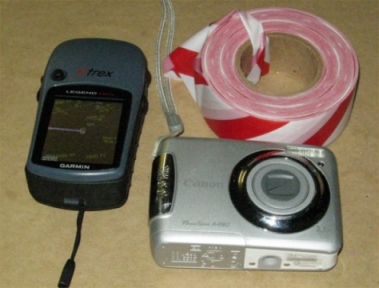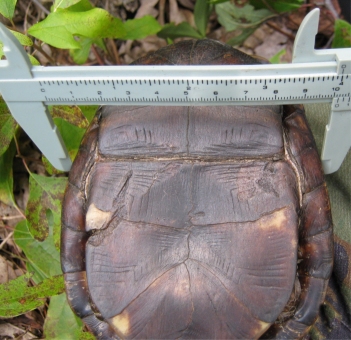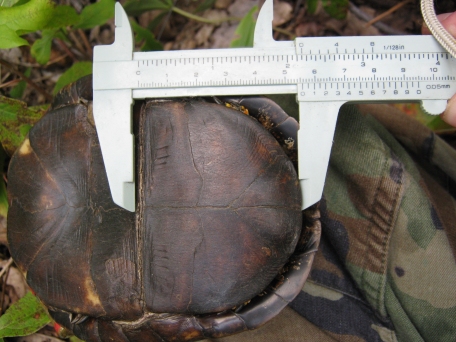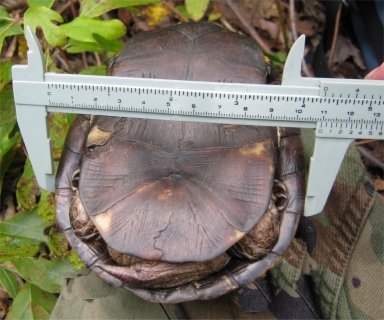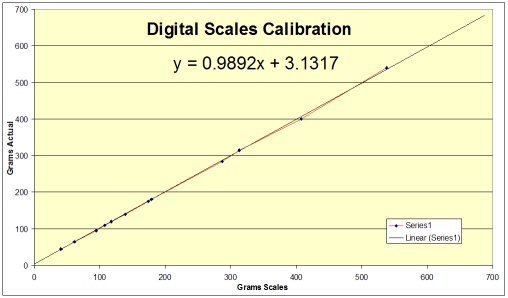The gender of a turtle is determined by looking at several characteristics. Males have a concaved depression in the plastron. Female platrons are flat or nearly so.
Males have a vent that is further back on the tail than females and have a longer tail. Many males also have more colorful heads and legs than females. Males usually exhibit flaired rear marginal scutes. Females have a high domed carapace, where the males' is somewhat flat.
Male box turtles usually (but not always) have bright red or orange eyes. Eye color in females is often red also, but is usually more muted, and is sometimes brown or yellow.
Observing mating and egg laying are sure clues to female determination.
Processing means weighing, measuring, sexing, aging, evaluating health and damage, and photographing for identification and documentation. It also includes file marking if that is being done, and might even include pit-tagging if that equipment is available.
Basically, processing is a complete description of each individual, and ultimately, a description of a population. Measurents are generally recorded in metric measures: centimeters (or milimeters), and grams, for consistancy.
Entry of all information into a spreadsheet makes sorting of information a breeze. This one contains the standard information collected, except age, which is a somewhat controversial subject with turtle researchers. Age class would be an option. Good, sharp close-ups of scutes, taken at initial processing, can be enlarged on a computer screen later for age determination.
Gender is easily determined after a little experience handling turtles. A chart is included lower on this page may also help.
Tools
At a minimum, calipers, fabric (sewing) measuring tape, and scale are necessary. I prefer to use plastic calipers. They are safer for both turtle and human, are accurate, light and inexpensive. I also carry flagging tape, a digital camera, and a digital thermometer (has both IR and thermister probe) to record soil, air and carapace temperatures and a GPS to record location.
The digital scale is accurate to within 5 grams, and was purchased for under 5 dollars. The flagging is used when weighing turtles, as well as location marking.
Step by Step Processing: Processing takes very little time, and can be done in the field. I prefer to use the same order every time when collecting data on newly found Box turtles so that I can be consistent and not forget to take any measurement. Every Box turtle has it's own personality, and needs to be handled in whatever way makes the job most efficient. Box turtles probably don't feel trauma when handled properly, and most seem to not mind at all. Those Box turtles that tend to be "squirmy", can sometimes be coaxed into it's shell for at least a short time by tapping on the front of the carapace with fingernail. Some turtles seem to enjoy being elevated so they can look around. Measuring is a two-handed job.
Start by turning the turtle on it's back and measuring the two plates of the plastron. The measurements can be taken with he shell open or closed using the appropriate side of the calipers.
Still on it's back, measure the width of the carapace at the hinge and find the place where the width of the carapace is widest and measure it.
Also go back to the hinge and measure the hinge itsself. The leathery parts of the hinge form a shape like >-------------< , measure from the >-- and --< intersections.
From the top, measure the straight-line length at the shell's midline using CALIPERS. It's possible that a high-domed female shell will interfer with short arm calipers, so try it from the bottom.
The "tape" dimension is measured with a fabric tape also front to back on the carapace midline. Be careful when reading the fabric tape as the numbers are not beside the mark in most cases.
Weighing is done on a hanging scale. The best way (of many ways tried) is to use a large wide rubber band around the turtle's bridge area. A length of flagging stretched tight and tied works well , also. This does not harm the turtle. Zero the scale, insert the hook under the rubber band (or flagging) and let the turtle hang free until the reading stabilizes (a few seconds). Weigh at least 3 times to assure accuracy.
Most turtles don't seem to mind dangling and many seem to enjoy having a good look around. It's best not to drop the turtle. A five gram acurracy scale is fine; when urinating they easily change weight by 5 or 10 grams (ml).
Height is measured from the lowest part of the plastron (when upright) to the highest part of the carpace. This is "Maximum Height".
Photographs are taken for several purposes: ID photos are the 6 general views as if shooting a box and are best duplicated several times using Macro mode at different distances. For ID purposes, clear plastron photos are more valuable, and easier to compare and contrast than carapace photos.
The carapace and plastron should be photographed to document damage and abnormalities, and the scutes photographed from several angles, including oblique, to show annuli clearly.
Photos are taken both with flash and without flash. In the woods, the extra light is needed for clear, in-focus photos, Coloration of carapace patterns is different in flash-ligt than in sunlight.
If the turtle shell is closed, turn the calipers around and use the inside measurement side.
Be careful when reading the fabric tape. This is 16.3 cm (or 163 mm).
When turtles are found while mating, record the mate's ID while you're at it.
The Digital Scales on the right cost only a few dollars on Ebay, and proves to be as accurate as any 5gr spring scales for field use (see calibration chart). The yellow one doesn't continuously get lost when set down in the woods, like the brown ones I used previously.
Aging Eastern Box turtles can be very difficult, so measuring the carapace length (for charting Class by Length) and weight ( for charting Class by Weight) is important in determining a population's makeup.
Terrapene carolina carolina
A Relict Population Doomed To Extinction?








